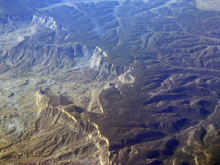Article
Black Mesa is an elevated, bowl-shaped region (approximately 4,000 square miles) located in northern Arizona. It is part of the Navajo Reservation; a portion of the Hopi Reservation; and some of the Navajo-Hopi Joint Use Area, which is claimed by both the Navajo and Hopi. The region of Black Mesa includes a mesa itself as well as the surrounding sloping hills, canyons, valleys, and four drainages that are tributaries of the Little Colorado River.
This area has been inhabited by Native peoples for over 7,000 years. It is significant to both the Hopi and the Navajo peoples, there are approximately 16,000 Navajo and 8,000 Hopis on Black Mesa. The Hopi reservation consists of twelve villages located on three mesas: First Mesa, Second Mesa, and Third Mesa, all of which are located upon the larger Black Mesa. The Hopi consider this land sacred and part of their tribal history and origin. For the Navajo peoples, Black Mesa is the sacred female mountain, also known as the Female Pollen Range, and is important to the frequently performed Blessingway ceremony. The Blessingway (Hózhójí) is used to bless the "one sung over," to ensure good luck, good health, and blessings for everything that pertains to them.
Black Mesa is a contested area among Anglo settlers and industrialists, the Hopi, and the Navajo peoples. Despite strong opposition from within and outside their communities, in 1966 the Navajo and Hopi tribal councils sold the mineral and aquifer rights on Black Mesa to the Peabody Coal Company for two million dollars a year. Peabody Coal has been accused of depleting the region’s aquifer; destroying sacred sites; strip-mining; and polluting the area, the Navajo called their actions the “rape of Earth Mother.” Under federal law PL 93-531, at least 12,000 to approximately 16,000 Navajos were forcefully relocated from Black Mesa, in the largest Indigenous relocation in the United States since the Trail of Tears. The Black Mesa mine was closed in 2005; however, in 2008 Peabody Coal received a permit to open again but were denied by administrative law judge in 2010 for not satisfying the National Environmental Policy Act (NEPA).
"The eastern edge of Black Mesa, west of Chilchinbito, Arizona" by Doc Searls is licensed under CC BY-SA.
Manuscripts
A05 Listening Woman (02-13) p. 99
A07 The Dark Wind (04-06), p. 1
A07 The Dark Wind (04-06), p. 17
A07 The Dark Wind (04-06), p. 22
A07 The Dark Wind (04-06), p. 23
A07 The Dark Wind (04-06), p. 43
A07 The Dark Wind (04-06), p. 58
A07 The Dark Wind (04-06), p. 82
A07 The Dark Wind (04-06), p. 84
A07 The Dark Wind (04-06), p. 88
A07 The Dark Wind (04-06), p. 107
A07 The Dark Wind (04-06), p. 115
A07 The Dark Wind (04-06), p. 124
A07 The Dark Wind (04-06), p. 126
A07 The Dark Wind (04-06), p. 127
A07 The Dark Wind (04-06), p. 188
A07 The Dark Wind (04-06), p. 193
A07 The Dark Wind (04-06), p. 210
A07 The Dark Wind (04-06), p. 214
A07 The Dark Wind (04-06), p. 227
A07 The Dark Wind (04-06), p. 231
A07 The Dark Wind (04-06), p. 243
A07 The Dark Wind (04-06), p. 246
A07 The Dark Wind (04-06), p. 260
A08 The Ghostway (05-03), p. 220
References
Iverson, Peter
2004 Navajo, Indians of North America, Heritage Edition. Philadelphia: Chelsea House
Publisher.
Linford, Laurance D.
2000 Navajo Places: History, Legend, Landscape. Salt Lake City: University of Utah Press.
Lynch, Patricia Ann
2004 Native American Mythology, Mythology A to Z. New York: Infobase Publishing.
Nies, Judith. Orion Magazine.
N.d. The Black Mesa Syndrome: Indian Lands, Black Gold.
https://orionmagazine.org/article/the-black-mesa-syndrome/, accessed March 15, 2016.

